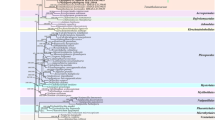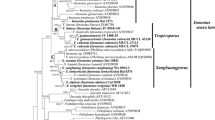Abstract
Previous molecular phylogenetic analysis in comparison with phenotype characters of Gomphillaceae resolved a total of 38 genus-level clades among the studied species, 17 of which in need to be recognized and formally established as new or reinstated genera. The four reinstated genus names, including one validation, are Microxyphiomyces Bat., Valle & Peres, Psathyromyces Bat. & Peres, Spinomyces Bat. & Peres ex Xavier-Leite, M. Cáceres & Lücking, gen. nov., and Sporocybomyces H. Maia. The remaining 13 are newly described: Adelphomyces Xavier-Leite, M. Cáceres & Lücking, gen. nov., Aptrootidea Xavier-Leite, M. Cáceres & Lücking, gen. nov., Aulaxinella Xavier-Leite, M. Cáceres & Lücking, gen. nov., Batistomyces Xavier-Leite, M. Cáceres & Lücking, gen. nov., Bezerroplaca Xavier-Leite, M. Cáceres & Lücking, gen. nov., Caleniella Xavier-Leite, M. Cáceres & Lücking, gen. nov., Monocalenia Xavier-Leite, M. Cáceres & Lücking, gen. nov., Pseudocalenia Xavier-Leite, M. Cáceres & Lücking, gen. nov., Roselviria Xavier-Leite, M. Cáceres & Lücking, gen. nov., Santricharia Xavier-Leite, M. Cáceres & Lücking, gen. nov., Sipmanidea Xavier-Leite, M. Cáceres & Lücking, gen. nov., Verruciplaca Xavier-Leite, M. Cáceres & Lücking, gen. nov., and Vezdamyces Xavier-Leite, M. Cáceres & Lücking, gen. nov. The following 53 new combinations are introduced for the species included in the new and reinstated genera: Adelphomyces cochlearifer (Lücking & Sérus.) Xavier-Leite, M. Cáceres & Lücking, comb. nov., A. epithallina (Lücking) Xavier-Leite, M. Cáceres & Lücking, comb. nov., A. parvula (Hafellner & Vězda) Xavier-Leite, M. Cáceres & Lücking, comb. nov., Aptrootidea amapensis (Bat. & Poroca) Xavier-Leite, M. Cáceres & Lücking, comb. nov., A. atrofusca (R. Sant.) Xavier-Leite, M. Cáceres & Lücking, comb. nov., A. atromuralis (Lücking) Xavier-Leite, M. Cáceres & Lücking, comb. nov., A. marginata (Lücking) Xavier-Leite, M. Cáceres & Lücking, comb. nov., A. triseptata (Lücking) Xavier-Leite, M. Cáceres & Lücking, comb. nov., A. wilsoniorum (Lücking) Xavier-Leite, M. Cáceres & Lücking, comb. nov., Aulaxinella corticola (Kalb & Vězda) Xavier-Leite, M. Cáceres & Lücking, comb. nov., A. minuta (R. Sant.) Xavier-Leite, M. Cáceres & Lücking, comb. nov., A. multiseptata (R. Sant.) Xavier-Leite, M. Cáceres & Lücking, comb. nov., Batistomyces pallidus (Vězda) Xavier-Leite, M. Cáceres & Lücking, comb. nov., B. hyalinus (Kalb & Vězda) Xavier-Leite, M. Cáceres & Lücking, comb. nov., Bezerroplaca fusconitida (Lücking) Xavier-Leite, M. Cáceres & Lücking, comb. nov., B. incrustatociliata (Sérus.) Xavier-Leite, M. Cáceres & Lücking, comb. nov., B. lucernifera (Kalb & Vězda) Xavier-Leite, M. Cáceres & Lücking, comb. nov., B. pachyparaphysata (R. Sant.) Xavier-Leite, M. Cáceres & Lücking, comb. nov., B. streimannii (Sérus.) Xavier-Leite, M. Cáceres & Lücking, comb. nov., Caleniella maculans (Vain.) Xavier-Leite, M. Cáceres & Lücking, comb. nov., C. triseptata (Zahlbr.) Xavier-Leite, M. Cáceres & Lücking, comb. nov., Microxyphiomyces cuneatus (L.I. Ferraro & Vězda) Xavier-Leite, M. Cáceres & Lücking, comb. nov., M. demoulinii (Sérus.) Xavier-Leite, M. Cáceres & Lücking, comb. nov., M. elegans (Sérus.) Xavier-Leite, M. Cáceres & Lücking, comb. nov., M. kashiwadanii (G. Thor, Lücking & Tat. Matsumoto) Xavier-Leite, M. Cáceres & Lücking, comb. nov., M. lancicarpus (Kalb & Vězda) Xavier-Leite, M. Cáceres & Lücking, comb. nov., M. vainioi (R. Sant.) Xavier-Leite, M. Cáceres & Lücking, comb. nov. (syn.: M. manaosensis Bat., Valle & Peres.), M. santessonianus (Kalb & Vězda) Xavier-Leite, M. Cáceres & Lücking, comb. nov., M. santessonii (D. Hawks.) Xavier-Leite, M. Cáceres & Lücking, comb. nov., M. similis (Vězda) Xavier-Leite, M. Cáceres & Lücking, comb. nov., M. variratae (Lücking & Sipman) Xavier-Leite, M. Cáceres & Lücking, comb. nov., Monocalenia monospora (Vězda) Xavier-Leite, M. Cáceres & Lücking, comb. nov., Psathyromyces planus (Vězda) Xavier-Leite, M. Cáceres & Lücking, comb. nov., P. heterellus (Stirt.) Xavier-Leite, M. Cáceres & Lücking, comb. nov., Pseudocalenia solorinoides (Lücking) Xavier-Leite, M. Cáceres & Lücking, comb. nov., Roselviria lobulimarginata (Sipman & Lücking) Xavier-Leite, M. Cáceres & Lücking, comb. nov., R. purulhensis (Lücking, Sérus. & Vězda) Xavier-Leite, M. Cáceres & Lücking, comb. nov., Santricharia farinosa (R. Sant.) Xavier-Leite, M. Cáceres & Lücking, comb. nov., Sipmanidea neotropica (Lücking) Xavier-Leite, M. Cáceres & Lücking, comb. et stat nov., S. furcata (Sérus.) Xavier-Leite, M. Cáceres & Lücking, comb. nov., Spinomyces aggregatus (Lücking) Xavier-Leite, M. Cáceres & Lücking, comb. et stat. nov., S. albostrigosus (Lücking, Sérus. & Vězda) Xavier-Leite, M. Cáceres & Lücking, comb. nov., S. deslooveri (Sérus.) Xavier-Leite, M. Cáceres & Lücking, comb. nov., S. guatemalensis (Lücking & Barillas) Xavier-Leite, M. Cáceres & Lücking, comb. nov., S. microcarpus (Etayo & Lücking) Xavier-Leite, M. Cáceres & Lücking, comb. nov., S. verrucosus (Sérus.) Xavier-Leite, M. Cáceres & Lücking, comb. nov., Sporocybomyces leucomuralis (Lücking) Xavier-Leite, M. Cáceres & Lücking, comb. nov., S. leucotrichoides (Vain.) Xavier-Leite, M. Cáceres & Lücking, comb. nov., S. macgregorii (Vain.) Xavier-Leite, M. Cáceres & Lücking, comb. nov., Verruciplaca calcarea (Lücking) Xavier-Leite, M. Cáceres & Lücking, comb. et stat. nov., V. verrucifera (Lücking) Xavier-Leite, M. Cáceres & Lücking, comb. nov., Vezdamyces albopruinosus (Lücking) Xavier-Leite, M. Cáceres & Lücking, comb. et stat. nov., and V. vulgaris (Müll. Arg.) Xavier-Leite, M. Cáceres & Lücking, comb. nov.




















Similar content being viewed by others
Data availability
All data used in this study are either directly cited (nomenclature) or are available through the cited references (underlying phylogeny and sequence data) or through the cited repositories (MycoBank registration numbers).
References
Batista AC (1961) Um pugilo de gêneros novos de líquens imperfeitos. Publ Inst Micol Univ Recife 320:1–31
Batista AC, Peres GEP (1964) Líquens imperfeitos: novos gêneros e espécies de Manaus. Anais XIV Congr Soc Bot Brasil:89–102
Batista AC, Maia HS (1967) Novos líquens imperfeitos do Amazonas e de Pernambuco. Atas Inst Micol Univ Fed Pernambuco 5:55–71
Batista AC, Poroca DJM (1970) Uma nova espécie de Echinoplaca, da Amazônia. Publ Inst Micol Univ Fed Pernambuco 635:1–8
Diederich P, Lawrey JD, Ertz D (2018) The 2018 classification and checklist of lichenicolous fungi, with 2000 non-lichenized, obligately lichenicolous taxa. Bryologist 121:340–425. https://doi.org/10.1639/0007-2745-121.3.340
Duby J (1830) Botanicon Gallicum 2: 545–1068 + XLI-LVIII, Paris
Esslinger TL (1975) A new North American species of the lichen genus Gomphillus. Mycotaxon 1:189–192
Hafellner J (1984) Studien in Richtung einer naturlicheren Gliederung der Sammelfamilien Lecanoraceae und Lecideaceae. Nova Hedwig Beih 79:41–371
Hafellner J (1988) Principles of classification and main taxonomic groups. In: Galun M (ed) CRC handbook of lichenology. Volume III. CRC Press, Boca Raton, Florida, pp 41–52
Henssen A, Jahns HM (1974). Lichenes. 467 pp. Stuttgart
Henssen A, Lücking R (2002) Morphology, anatomy, and ontogeny in the Asterothyriaceae (Ascomycota: Ostropales), a misunderstood group of lichenized fungi. Ann Bot Fenn 39:273–299 https://www.jstor.org/stable/23727132
Jahns HM (1970) Untersuchungen zur Entwicklungsgeschichte der Cladoniaceen unter besonderer Berücksichtigung des Podetien-Problems. Nova Hedwigia 20:i–vi + 1–177
Kraichak E, Huang JP, Nelsen MP et al (2018) A revised classification of orders and families in the two major subclasses of Lecanoromycetes (Ascomycota) based on a temporal approach. Bot J Linn Soc 188:233–249. https://doi.org/10.1093/botlinnean/boy060
Lücking R (1997) Additions and corrections to the knowledge of the foliicolous lichen flora of Costa Rica. The family Gomphillaceae Biblioth Lichenol 65:1–109
Lücking R (1999) Adicciones y correcciones al conocimiento de la liquenoflora foliícola de Costa Rica. La familia Asterothyriaceae y el género Chroodiscus (Thelotremataceae), con un análisis filogenético. Cryptogam Mycol 20:193–224. https://doi.org/10.1016/S0181-1584(00)87029-3
Lücking R (2008) Foliicolous lichenized fungi. Fl Neotr. Monogr 103:1–873
Lücking R (2019) Stop the abuse of time! Strict temporal banding is not the future of rank-based classifications in fungi (including lichens) and other organisms. Crit Rev Pl Sci 38:199–253. https://doi.org/10.1080/07352689.2019.1650517
Lücking R, Sérusiaux E, Maia LC, Pereira ECG (1998) A revision of the names of foliicolous lichenized fungi published by Batista and co-workers between 1960 and 1975. Lichenologist 30:121–191
Lücking R, Stuart BL, Lumbsch HT (2004) Phylogenetic relationships of Gomphillaceae and Asterothyriaceae: evidence from a combined Bayesian analysis of nuclear and mitochondrial sequences. Mycologia 96:283–294. https://doi.org/10.2307/3762064
Lücking R, Sérusiaux E, Vӗzda A (2005) Phylogeny and systematics of the lichen family Gomphillaceae (Ostropales) inferred from cladistic analysis of phenotype data. Lichenologist 37:123–170
Lücking R, Hodkinson BP, Leavitt SD (2017) (‘2016’) The 2016 classification of lichenized fungi in the Ascomycota and Basidiomycota – approaching one thousand genera. Bryologist 119:361–416. https://doi.org/10.1639/0007-2745-119.4.361
Müller J (1881) Lichenologische Beiträge XII (Schluss). Flora 64:100–112
Müller J (1891) Lichenes. In: Durand T, Pittier H (eds) Primitiae Florae Costaricensis. Bull Soc R Bot Belg 30:49–97
Nylander W (1855) Essai d'une nouvelle classification des lichens (second memoire). Mém Soc Sci Nat 3:161–202
Nylander W (1860) De lichenibus nonnullis europaeis. Flora 43:545–547
Poelt J (1973) Classification. In: Ahmadjian V, Hale ME (eds) The Lichens. Academic Press, New York, London, pp 599–632
Rivas Plata E, Lücking R, Lumbsch HT (2012) A new classification for the family Graphidaceae (Ascomycota: Lecanoromycetes: Ostropales). Fungal Divers 52:107–121. https://doi.org/10.1007/s13225-011-0135-8
Santesson R (1952) Foliicolous lichens I. A revision of the taxonomy of the obligately foliicolous, lichenized fungi. Symb Bot Upsal 12(1):1–590
Sérusiaux E (1984) Three new species of Tricharia (Lichenes, Asterothyriaceae) from New Guinea. Mycologia 76:108–114. https://doi.org/10.2307/3792841
Vainio EA (1896) Lichenes antillarum a W. R. Elliott collecti (continued). Aust J Bot 34:204–210
Vězda A (1973) Foliicole Flechten aus der Republik Guinea (W-Afrika). I. Acta Mus Silesiae Ser A [Opava] 22:67–90
Vězda A (1979) Flechtensystematische Studien. XI. Beiträge zur Kenntnis der Familie Asterothyriaceae (Discolichenes). Folia Geobot Phytotax 14:43–94 https://www.jstor.org/stable/4180073
Vězda A, Poelt J (1987) Flechtensystematische Studien. XII. Die Familie Gomphillaceae und ihre Gliederung. Folia Geobot Phytotax 22:179–198 https://www.jstor.org/stable/4180761
Vězda A, Poelt J (1990) Solorinellaceae, eine neue Familie der lichenisierten Ascomyceten. Phyton [Austria] 30:47–55
Watson W (1929) The classification of lichens. Part I New Phytol 28:1–36. https://doi.org/10.1111/j.1469-8137.1929.tb06745.x
Xavier-Leite AB, Cáceres MES, Aptroot A et al (2022) Phylogenetic revision of the lichenized family Gomphillaceae (Ascomycota: Graphidales) suggests post-K–Pg boundary diversification and phylogenetic signal in asexual reproductive structures. Mol Phylogenet Evol 168:107380. https://doi.org/10.1016/j.ympev.2021.107380
Xavier-Leite AB, Goto BT, Cáceres MES et al (2023) Reclassification of species in the lichenized family Gomphillaceae (Ascomycota: Ostropales) using morphology-based phylogenetic binning, Cryptogam Mycol (in press)
Zahlbruckner A (1907) Lichenes (Flechten) B. Specieller Teil. I. Teil, 1. Abteilung. In: Engler A, Prantl K (eds) Die Natürlichen Pflanzenfamilien, Engelmann, Leipzig, pp 97–144
Acknowledgements
We thank Elise Lebreton for the valuable input concerning the generic classification of Gomphillaceae. This article is part of the PhD thesis of Amanda Barreto Xavier Leite.
Funding
The Coordenação de Aperfeiçoamento de Pessoal de Nível Superior (CAPES) is thanked for a PhD scholarship to ABXL. The Conselho Nacional de Desenvolvimento Científico e Tecnológico (CNPq) is thanked for supporting the work abroad at the Botanical Garden and Botanical Museum Berlin Berlin (Processo 207282/2015-3), for funding for the collecting trips (Processo 401186/2014-8), and for supporting a collaborative project with RL as Special Visiting Professor (Processo 314570/2014-4), as well as for the research grants to MESC (Processos 309058/2015-5 and 307569/2029-5) and BTG (300982/2016-3).
Author information
Authors and Affiliations
Contributions
ABXL, BTG, RL and MESC designed the study. ABXL provided draft descriptions of the new genera and ABXL and RL made the final descriptions. ABXL and RL assembled the new species combinations and the draft manuscript. All authors revised the manuscript and agreed on its final form.
Corresponding author
Ethics declarations
Competing interests
The authors declare no competing interests.
Additional information
Section Editor: Gerhard Rambold
Publisher’s note
Springer Nature remains neutral with regard to jurisdictional claims in published maps and institutional affiliations.
Rights and permissions
Springer Nature or its licensor (e.g. a society or other partner) holds exclusive rights to this article under a publishing agreement with the author(s) or other rightsholder(s); author self-archiving of the accepted manuscript version of this article is solely governed by the terms of such publishing agreement and applicable law.
About this article
Cite this article
Xavier-Leite, A.B., Goto, B.T., Lücking, R. et al. New genera in the lichenized family Gomphillaceae (Ascomycota: Graphidales) focusing on neotropical taxa. Mycol Progress 22, 88 (2023). https://doi.org/10.1007/s11557-023-01933-1
Received:
Revised:
Accepted:
Published:
DOI: https://doi.org/10.1007/s11557-023-01933-1




